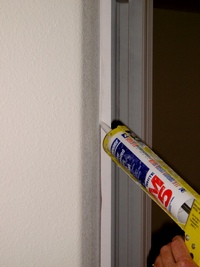High quality siliconized acrylic caulk is a good choice for many interior or exterior painting projects. This type of caulking remains flexible over a wide range of temperatures. Siliconized acrylic sealants have become the standard painters caulk because it is able to adhere to a wide range of materials. Plus, siliconized acrylic caulk is fully paintable with both acrylic or alkyd paints when fully cured.
Be careful not to get 100% silicone caulk. In fact, it is a good idea to always read the label on any caulking material. Look for the words “paintable.” If the caulk doesn’t say this, the paint may bead up and peel right off.
Also make sure you don’t purchase regular acrylic caulk. While acrylic caulking is a good general-purpose sealant that can last for a few years, it isn’t as durable as siliconized acrylic caulk. Even with the addition of silicone to the formula, this type of caulking compound will eventually harden and split.
Siliconized acrylic caulk is suitable for exterior caulking applications, such as sealing around windows or doors and gaps between fascia boards or siding. It works for filling small cracks and holes as well.
Generally interior surfaces move less because they aren’t exposed to the warming rays of the sun or cold rain, wind or snow. This doesn’t mean that they don’t need to be caulked. Indoors there are different reasons to caulk, but they are valid reasons. Interior caulking applications still require a good sealant.
Choose the Right Caulk to Seal Exterior and Interior Painting Projects
All painting products are manufactured in different grades of quality, and caulking is no exception. The cheaper products will harden and crack sooner.
When you start comparing sealants you will find that most sealants have a number associated with their useful life span, for example the rating may be 20 years. This represents the number of years the manufacturer assumes the caulking will remain flexible and adhere to a given surface. This number is based on testing.
Follow this general rule when choosing an acrylic caulk. Select the highest number possible. Just remember this number is based on assumptions and lab tests. The caulking won’t actually last this long unless it is kept in the tube.
How to Apply Caulk

The surfaces to be caulked should be sound and stable offering very little movement. If the two opposing surfaces move, the caulk will be more prone to pulling away over time. Ensure siding, etc. is in good repair and securely fastened.
Siliconized acrylic sealants have good paint crack resistance and tooling characteristics as long as the gaps aren’t too great between surfaces. Most caulking compounds can be used on gaps of 1/4 inch or less. Wider gaps will require two applications. If a crack is deep, use a backer rod.
Always choose a good name brand or consult with your local paint store for recommendations.



4 Responses
Can you use polyurethane over acrylic caulk?
Yes you can. Remember to remove any loose caulking before applying the poly sealant.
I regrouted a customer’s counter top using Mapei grout and mixed it with epoxy resin from thegroutstore.com because of the more permanent bond. It did not solve the problem because the grout still cracked. I want to try this siliconized acrylic caulking because of its flexibility but I want to apply it where it is cracking without removing the grout. Do you have any advice?
Apply a small bead and have warm water and clean rags at hand to wipe off the excess and have a clean tile edge. You will have to tool it with your finger so be careful and don’t apply too much. Other than that the caulking will stick well but color might be an issue.